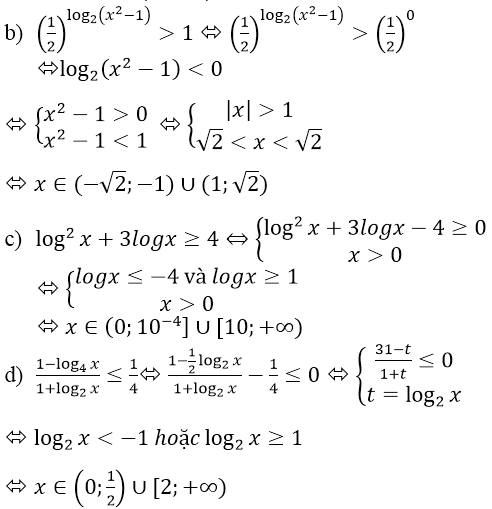Hãy nhập câu hỏi của bạn vào đây, nếu là tài khoản VIP, bạn sẽ được ưu tiên trả lời.

Đặt \(\sqrt{x^2-5x+5}=t>0\)
\(\Rightarrow log_2\left(t+1\right)+log_3\left(t^2+2\right)-2=0\)
Nhận thấy \(t=1\) là 1 nghiệm của pt
Xét hàm \(f\left(t\right)=log_2\left(t+1\right)+log_3\left(t^2+2\right)-2\)
\(f'\left(t\right)=\dfrac{1}{\left(t+1\right)ln2}+\dfrac{2t}{\left(t^2+2\right)ln3}>0\Rightarrow f\left(t\right)\) đồng biến
\(\Rightarrow f\left(t\right)\) có tối đa 1 nghiệm
\(\Rightarrow t=1\) là nghiệm duy nhất của pt
\(\Rightarrow\sqrt{x^2-5x+5}=1\Rightarrow\left[{}\begin{matrix}x=1\\x=4\end{matrix}\right.\)

\(ĐKXĐ:x>2\)
BPT đã cho tương đương với:
\(2log_2\sqrt{x+1}+log_2\left(x-2\right)\le2\)
\(\Leftrightarrow log_2\left(x+1\right)+log_2\left(x-2\right)\le2\)
\(\Leftrightarrow log_2\left(x^2-x-2\right)\le2\)\(\Leftrightarrow0< x^2-x-2\le2^2\)\(\Leftrightarrow\left[{}\begin{matrix}2< x\le3\\-2\le x< -1\left(l\right)\end{matrix}\right.\)
Vậy tổng các nghiệm nguyên của bpt là 3

a. Vì \(0< 0,1< 1\) nên bất phương trình đã cho
\(\Leftrightarrow0< x^2+x-2< x+3\)
\(\Leftrightarrow\left\{{}\begin{matrix}x^2+x-2>0\\x^2-5< 0\end{matrix}\right.\)
\(\Leftrightarrow\left\{{}\begin{matrix}\left[{}\begin{matrix}x< -2\\x>1\end{matrix}\right.\\-\sqrt{5}< x< \sqrt{5}\end{matrix}\right.\)
\(\Leftrightarrow\left\{{}\begin{matrix}-\sqrt{5}< x< -2\\1< x< \sqrt{5}\end{matrix}\right.\)
Vậy tập nghiệm của bất phương trình là \(S=\left\{-\sqrt{5};-2\right\}\) và \(\left\{1;\sqrt{5}\right\}\)
b. Điều kiện \(\left\{{}\begin{matrix}2-x>0\\x^2-6x+5>0\end{matrix}\right.\)
Ta có:
\(log_{\dfrac{1}{3}}\left(x^2-6x+5\right)+2log^3\left(2-x\right)\ge0\)
\(\Leftrightarrow log_{\dfrac{1}{3}}\left(x^2-6x+5\right)\ge log_{\dfrac{1}{3}}\left(2-x\right)^2\)
\(\Leftrightarrow x^2-6x+5\le\left(2-x\right)^2\)
\(\Leftrightarrow2x-1\ge0\)
Bất phương trình tương đương với:
\(\left\{{}\begin{matrix}x^2-6x+5>0\\2-x>0\\2x-1\ge0\end{matrix}\right.\) \(\Leftrightarrow\left\{{}\begin{matrix}\left[{}\begin{matrix}x< 1\\x>5\end{matrix}\right.\\x< 2\\x\ge\dfrac{1}{2}\end{matrix}\right.\)
\(\Leftrightarrow\dfrac{1}{2}\le x< 1\)
Vậy tập nghiệm của bất phương trình là: \(\left(\dfrac{1}{2};1\right)\)

Điều kiện :
\(\begin{cases}x^2-4x+5>0\\3+\log_2\left(x^2-4x+5\right)\ge0\\5-\log_2\left(x^2-4x+5\right)\ge0\end{cases}\)
\(\Leftrightarrow x^2-4x+5\le2^5\)
\(\Leftrightarrow2-\sqrt{29}\le x\)\(\le2+\sqrt{29}\)
Đặt \(\begin{cases}u=\sqrt{3+\log_2\left(x^2-4x+5\right)}\\v=\sqrt{5-\log_2\left(x^2-4x+5\right)}\end{cases}\) \(\left(v,u\ge0\right)\)
Khi đó ta có hệ phương trình :
\(\begin{cases}u^2+v^2=8\\u+2v=6\end{cases}\)
Giải ra ta được :
\(\begin{cases}u=2\\v=2\end{cases}\) hoặc \(\begin{cases}u=\frac{2}{5}\\v=\frac{14}{5}\end{cases}\)
Từ đó suy ra \(\log_2\left(x^2-4x+5\right)=1\) hoặc \(\log_2\left(x^2-4x+5\right)=\frac{-71}{25}\) và tìm được 4 nghiệm của phương trình

Điều kiện \(\begin{cases}x\ne1\\x>\frac{1}{2}\end{cases}\)
\(\log_3\left(x-1\right)^2+\log_{\sqrt{3}}\left(2x-1\right)=2\Leftrightarrow2\log_3\left|x-1\right|+2\log_3\left(2x-1\right)=2\)
\(\Leftrightarrow\log_3\left|x-1\right|\left(2x-1\right)=\log_33\)
\(\Leftrightarrow\left|x-1\right|\left(2x-1\right)=3\)
\(\frac{1}{2}\)<x<1 và \(2x^2-3x+4=0\)
hoặc x>1 và \(2x^2-3x-2=0\)
\(\Leftrightarrow x=2\) thỏa mãn điều kiện. Vậy x=2

Điều kiện x>1
Từ (1) ta có \(\log_{\sqrt{3}}\frac{x+1}{x-1}>\log_34\) \(\Leftrightarrow\frac{x+1}{x-1}>2\) \(\Leftrightarrow\) 1<x<3
Đặt \(t=\log_2\left(x^2-2x+5\right)\)
Tìm điều kiện của t :
- Xét hàm số \(f\left(x\right)=\log_2\left(x^2-2x+5\right)\) với mọi x thuộc (1;3)
- Đạo hàm : \(f\left(x\right)=\frac{2x-2}{\ln2\left(x^2-2x+5\right)}>\) mọi \(x\in\left(1,3\right)\)
Hàm số đồng biến nên ta có \(f\left(1\right)\) <\(f\left(x\right)\) <\(f\left(3\right)\) \(\Leftrightarrow\)2<2<3
- Ta có \(x^2-2x+5=2'\)
\(\Leftrightarrow\) \(\left(x-1\right)^2=2'-4\)
Suy ra ứng với mõi giá trị \(t\in\left(2,3\right)\) ta luôn có 1 giá trị \(x\in\left(1,3\right)\)
Lúc đó (2) suy ra : \(t-\frac{m}{t}=5\Leftrightarrow t^2-5t=m\)
Xét hàm số : \(f\left(t\right)=t^2-5t\) với mọi \(t\in\left(2,3\right)\)
- Đạo hàm : \(f'\left(t\right)=2t-5=0\Leftrightarrow t=\frac{5}{2}\)
- Bảng biến thiên :
| x | 2 \(\frac{5}{2}\) 3 |
| y' | + 0 - |
| y | -6 -6 -\(\frac{25}{4}\) |
Để hệ có 2 cặp nghiệm phân biệt \(\Leftrightarrow-6>-m>-\frac{25}{4}\)\(\Leftrightarrow\)\(\frac{25}{4}\) <m<6

Điều kiện \(x^2-1>0\Leftrightarrow\left|x\right|>1\)
Bất phương trình tương đương với :
\(\log_3\log_{\frac{1}{2}}\left(x^2-1\right)<\log_3\Leftrightarrow0<\log_{\frac{1}{2}}\left(x^2-1\right)<3\)
\(\Leftrightarrow\log_{\frac{1}{2}}1<\log_{\frac{1}{2}}\left(x^2-1\right)<\log_{\frac{1}{2}}\frac{1}{8}\Leftrightarrow1>x^2-1>\frac{1}{8}\)
\(\Leftrightarrow2>x^2>\frac{9}{8}\)
\(\Leftrightarrow\sqrt{2}>\left|x\right|>\frac{3}{2\sqrt{2}}\) (Thỏa mãn)
Vậy tập nghiệm của bất phương trình là \(D=\left(-\sqrt{2};\frac{-3}{2\sqrt{2}}\right)\cup\left(\frac{3}{2\sqrt{2}};\sqrt{2}\right)\)




Đặt :
\(t=\sqrt{x^2-5x+5}\left(t\ge0\right)\)
Bất phương trình trở thành :
\(\log_2\left(t+1\right)+\log_3\left(t^2+2\right)\le2\)
Xét \(f\left(t\right)=\log_2\left(t+1\right)+\log_3\left(t^2+2\right)\) trên \(\left(0;+\infty\right)\)
Do \(t\ge0\) nên \(\log_2\left(t+1\right)\) và \(\log_3\left(t^2+2\right)\) đều là các hàm số đồng biến, do đó f(t) đồng biến trên \(\left(0;+\infty\right)\)
Lại có f(1)=2, từ đó suy ra \(t\le1\)Giải ra được :\(1\le x\)\(\le\frac{5-\sqrt{5}}{2}\) hoặc \(\frac{5-\sqrt{5}}{2}\le x\) \(\le4\)